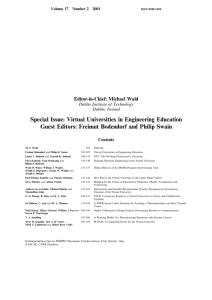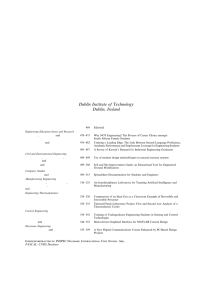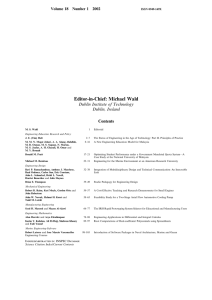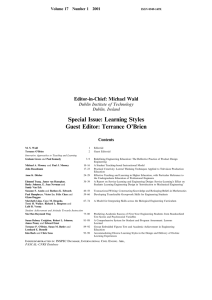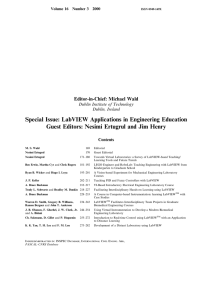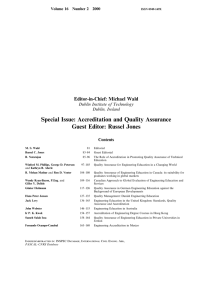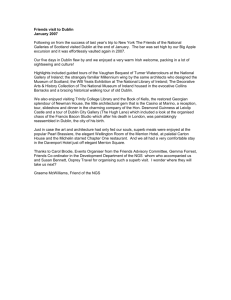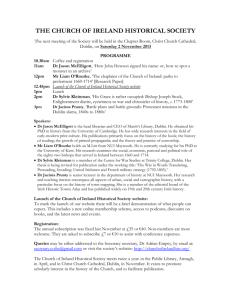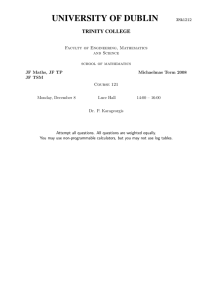Editor-in-Chief: Michael Wald Dublin Institute of Technology Dublin, Ireland Contents
advertisement
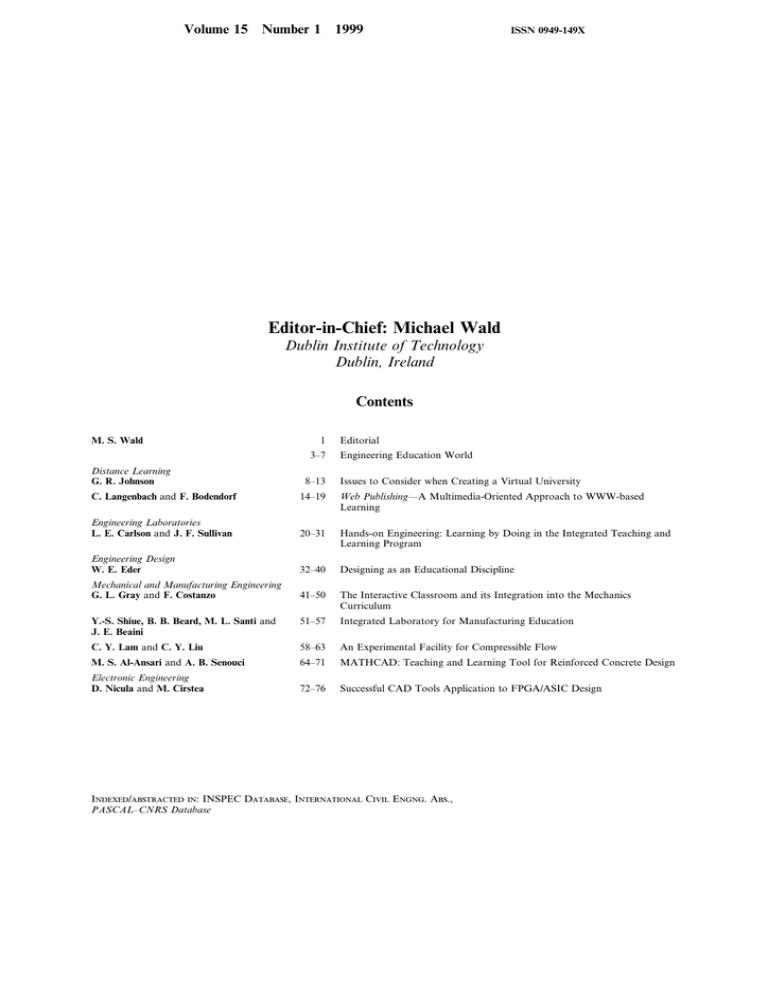
Volume 15 Number 1 1999 ISSN 0949-149X Editor-in-Chief: Michael Wald Dublin Institute of Technology Dublin, Ireland Contents M. S. Wald 1 3±7 Distance Learning G. R. Johnson 8±13 Editorial Engineering Education World Issues to Consider when Creating a Virtual University C. Langenbach and F. Bodendorf 14±19 Web PublishingÐA Multimedia-Oriented Approach to WWW-based Learning Engineering Laboratories L. E. Carlson and J. F. Sullivan 20±31 Hands-on Engineering: Learning by Doing in the Integrated Teaching and Learning Program Engineering Design W. E. Eder 32±40 Designing as an Educational Discipline Mechanical and Manufacturing Engineering G. L. Gray and F. Costanzo 41±50 The Interactive Classroom and its Integration into the Mechanics Curriculum Y.-S. Shiue, B. B. Beard, M. L. Santi and J. E. Beaini 51±57 Integrated Laboratory for Manufacturing Education C. Y. Lam and C. Y. Liu 58±63 An Experimental Facility for Compressible Flow M. S. Al-Ansari and A. B. Senouci 64±71 MATHCAD: Teaching and Learning Tool for Reinforced Concrete Design Electronic Engineering D. Nicula and M. Cirstea 72±76 Successful CAD Tools Application to FPGA/ASIC Design Indexed/abstracted in: INSPEC Database, International Civil Engng. Abs., PASCAL±CNRS Database The International Journal of ENGINEERING EDUCATION Editor-in-Chief M. S. Wald, Dublin Institute of Technology, Bolton Street, Dublin, Ireland Tel: (International +353 1) 4023635; Fax: (+353 1) 4023999; E-Mail: wald@dit.ie Website: http://www.ijee.dit.ie. Editor's direct phone: (+353 27) 61400. Mobile: (+49 172) 5106092 Associate Editors C. Kuo, University of Strathclyde, 100 Montrose St., Glasgow G4 0LZ, Scotland Tel: (International +44-141) 552 4400; E-mail: c.kuo@strath.ac.uk L. S. Fletcher, Department of Mechanical Engineering, Texas A&M University, College Station, TX 77843, USA D. McCarthy, Dublin Institute of Technology, Bolton St., Dublin, Ireland M. Murphy, Dublin Institute of Technology, Bolton St., Dublin, Ireland J. Turner, Dublin Institute of Technology, Bolton St., Dublin, Ireland Board of Editors B. Bergman, Division of Quality Technology, LinkoÈping University, S-581 83, LinkoÈping, Sweden C. Y. Lam, School of Mechanical and Production Engineering, Nanyang Technological University, Singapore 639798 S. Malasri, School of Engineering, Christian Brothers University, Memphis TN 38104, USA R. Natarajan, Department of Mechanical Engineering, Indian Institute of Technology, Madras 600-036, India E. Roche, New Jersey Institute of Technology, Newark, NJ 07102, USA C. S. Slater, Department of Chemical Engineering, Rowan College, Glassboro, NJ 08028, USA S. Waks, Department of Education in Technology & Science, Israel Institute of Technology, Haifa 32000, Israel Editorial Advisory Board F. Bodendorf, Department of Information Systems, University of Nuremberg-Erlangen, Germany E. Dagless, Department of Electrical and Electronic Engineering, University of Bristol, Queens Building, Bristol BS8 1TR, UK E. Eder, Royal Military College of Canada, Kingston, Ontario, Canada K7K 5LO I. Gibson, Industrial Engineering Department, National University of Ireland, Galway, Ireland R. C. Jones, Director, 2001 Mayfair McLean Court, Falls Church, VA 22043-1761, USA Gretchen Kalonji, Department of Materials Science & Engineering, University of Washington, Seattle WA 98195, USA R. Latorre, Naval Architecture and Marine Engineering, University of New Orleans, New Orleans, LA 70148, USA B. Malys, Lehrstuhl fuÈr Kommunikationstechnik, TU Cottbus, 03044 Cottbus, Germany J. H. F. Meyer, Education Building, University of Cape Town, Rondebosch 7700, South Africa C. Newberry, Aeronautics and Astronautics, Naval Postgraduate School, Monterey, CA 93943, USA A. Petrenko, CAD Department, Kiev Polytechnical Institute, Ukraine S. Pomeranz, Department of Mathematical and Computer Sciences, University of Tulsa, Tulsa, OK, USA Z. J. Pudlowski, Faculty of Engineering, Monash University, Clayton, Melbourne, Vic 3168, Australia N. J. Salamon, Engineering Science and Mechanics, The Pennsylvania State University, University Park, PA 16802, USA Sheri D. Sheppard, Mechanical Engineering, Stanford University, Stanford, CA 94305, USA. K. Yamazaki, Department of Mechanical Aeronautical and Materials Engineering, University of California, Davis CA 95616, USA 1999 Subscription Rates (including postage and insurance) Annual institutional subscription rate £290. Personal subscription rate for those whose library subscribes £75. For North American institutional subscribers $475. Subscription enquiries should be sent to TEMPUS Publications, Dublin Institute of Technology, Bolton St., Dublin, Ireland. Tel: (+353 1) 4023635, Fax (+353 1) 4023999. Back Issues Back issues available from University Microfilms, 1 Apple Tree Square, Suite 1548, Bloomington, MN 55424, USA. Tel: +1 612 853 0225. Fax: +1 612 853 0287. Copyright A 1998 TEMPUS Publications Published 6 per annum It is a condition of publication that manuscripts submitted to this journal have not been published and will not be simultaneously submitted or published elsewhere. By submitting a manuscript, the authors agree that the copyright for their article is transferred to the publisher if and when the article is accepted for publication. However, assignment of copyright is not required from authors who work for organizations which do not permit such assignment. The copyright covers the exclusive rights to reproduce and distribute the article, including reprints, photographic reproductions, microform or any other reproductions of similar nature and translations. No part of this publication may be reproduced, stored in a retrieval system or transmitted in any form or by any means, electronic, electrostatic, magnetic tape, mechanical, photocopying, recording or otherwise, without permission in writing from the copyright holder. Photocopying Information for Users in the U.S.A. The Item-fee Code for this publication indicates that authorization to photocopy items for internal or personal use is granted by the copyright holder for libraries and other users registered with the Copyright Clearance Center (CCC) Transactional Reporting Service provided the stated fee for copying beyond that permitted by Section 107 or 108 of the United States Copyright Law, is paid. The appropriate remittance of $3.00 per copy per article is paid directly to the Copyright Clearance Center Inc., 27 Congress Street, Salem, MA 01970, USA. Permission for Other Use The copyright owner's consent does not extend to copying for general distribution, for promotion, for creating new works, or for resale. Specific written permission must be obtained from the publisher for such copying. The Item-fee Code for this publication is: 0949-149X/92 $3.00 + 0.00. The International Journal of ENGINEERING EDUCATION Aims and Scope This journal serves as an international interdisciplinary forum and source of reference for engineering education. A balance between papers on developments in educational methods and technology, case studies, laboratory applications, new theoretical approaches, educational policy and survey papers is aimed for. Comprehensive coverage of new education schemes and techniques makes the journal a unique source of ideas for engineering educators who are keen to keep abreast with latest developments in educational applications in all fields of engineering. The journal will cover engineering education news and open debates on engineering education policy related topics of transnational interest. Some of the areas covered more extensively in recent issues are: CAD, CAE, computer applications in teaching thermodynamics, materials science, electrical engineering, new courses and curricula, engineering management, control engineering, mechanical engineering, engineering design, student evaluation and institutional accreditation. Features are a series on world educational systems with reference to engineering and a software survey section. Special issues on topics such as computer-aided engineering, engineering thermodynamics and engineering design are published periodically. Notes for Contributors Papers for inclusion in the Journal should be submitted in duplicate to the Editor-in-Chief or to the most appropriate member of the Board of Editors or the Editorial Board. The Editor-in-Chief should be informed by the authors of any submission made directly to a member of either Board. The papers should include detailed information on relevance of the material to engineering education. Only papers not previously published will be accepted and, once accepted for the Journal, must not be published elsewhere. Technical Notes, Letters-to-the-Editor and Book Reviews may also be submitted. In addition to the paper in manuscript form papers should also be submitted as an ASCII code file on a diskette suitable for IBM PC or Apple Macintosh. News items of transnational interest, including courses and workshops, should be submitted to the Editor-in-Chief. Selected papers and Journal information are available on the World Wide Web on http://www.ijee.dit.ie Papers must be submitted in English. A brief summary (not more than 100 words) of the scope of each paper must be sent with the manuscript. Authors are requested to submit a brief biograhical sketch of up to 100 words for each author. Biographical sketches will be published with the paper unless requested otherwise. The text, and as much of the mathematics as possible, must be typed with double spacing and ample margins on successively numbered pages. The manuscript and diagrams will be discarded one month after publication unless the publisher is requested to return the original material to the author. All photographs, schematics and diagrams should be referred to as figures and should be numbered consecutively and not included in the typescript. Name(s) of author(s), figure number and an indication of the orientation should be written on the back of each figure. Line diagrams should be drawn clearly in black ink with open lettering and be of sufficiently large size to allow for the necessary reduction. Photographs should be kept to a minimum and submitted as glossy prints. It is preferred to have graphics on diskette in GIF format. In the interest of economy and in order to avoid the introduction of errors, tables will be reproduced directly from the authors' manuscripts. In case of difficulty please consult the Photoreprographic Unit of your institution. The following points should be observed during their preparation. 1. Insert heavy rules at the head and foot of each table, and fine rules below column headings. 2. The type should be clear and even. Captions for figures and tables must be given on a separate sheet and included at the end of the manuscript. The journal follows Le SysteÁme International d'UniteÂs. All Greek characters and unusual symbols must be identified by name in the margin the first time they appear. References in the text to published literature should be given by numbers in square brackets on the line and the references should be listed at the end of the paper in numerical order. Journal references should be arranged thus: 1. L. A. Pipes, Matrix analysis of heat transfer problems. J. Franklin Inst. 263, 195±206 (1957). Book references should be given as: 2. P. H. Parkin and H. R. Humphreys, Acoustics, Noise and Buildings, p. 84. Faber, London (1961). Abbreviations of journal titles will follow World List of Scientific Periodicals. Proofs will be sent to the first-named author for correction, unless otherwise specified. Corrections must be restricted to printer's errors only. Other than these, any substantial changes may be charged to the author. Vol. 15, No. 1, pp. 1±76 INT. J. ENGINEERING EDUCATION 1999 A selection of papers accepted for publication McLaughlinÐEngineering Education in IrelandÐAn Institute of Technology Experience Eftekhar and StrongÐTowards Dynamic Modelling of a Teaching Learning SystemÐ The Simulation Model Al-JayyousiÐIntroduction of Lateral Thinking to Civil and Environmental Engineering Education R. NatarajanÐThe Role of Accreditation in Promoting Quality Assurance of Technical Education Lozano-NietoÐDeveloping Interprofessional skills in a Clinical Engineering Program TaylorÐMathematics Support Program for Commencing Engineering students between 1990 and 1996: an Australian case study Kaminskyj and ChapmanÐTran-Mechanistic Simulation in Electronics Engineering Education Askarpour and OwensÐOn the Non-Uniqueness of Characteristic Vectors Perez-Blanco, Michaleris, Hall and PaiÐA Vibration Test Stand for a Thermal Systems Laboratory Mallalieu and ArieatasÐInternet Enabled Parallel Port Driver MaixnerÐThe Use of Mathcad in Teaching Ideal Fluid Flow with Complex Variables VarsavskyÐElectronic Delivery of MathematicsÐWhat is possible with the Current Technology? Clarke and McClellandÐTeamwork at the ChalkfaceÐAn Integrated Approach to Technology and Design Wade, Grimson and PowerÐWorld Wide Web Based Educational Environments for Software Engineers McGinnity, Maguire and McDaidÐFlexible Learning in a Cross Border Environment
